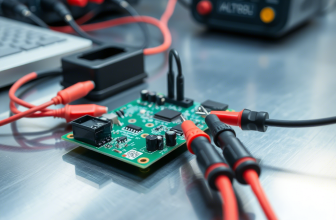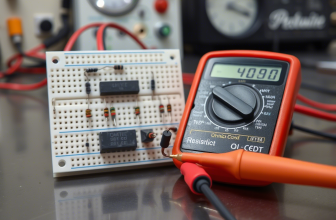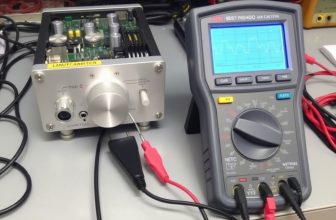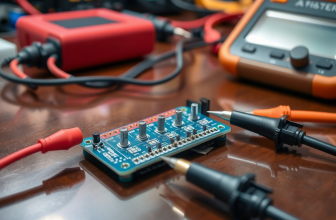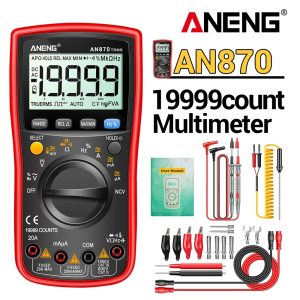After our guide to measure resistors, measure frequency and measure current with a multimeter. Measuring coils with a multimeter might sound like something only electricians or electronics experts do, but the truth is, anyone can learn how.
Whether you’re trying to figure out why your car won’t start, your speaker isn’t working properly, or your DIY circuit keeps failing, knowing how to measure coils with a multimeter can be incredibly useful.
Table of Contents
In this article titled “Multimeter How to Measure Coils,” we’ll walk you through everything you need to know in simple, easy-to-understand language. No confusing jargon, no complicated math—just clear instructions for complete beginners.
A coil, also known as an inductor, is a basic electronic component that stores energy in a magnetic field when electricity flows through it. Coils are used in many applications, from speakers and motors to transformers and power supplies.
However, just like any other component, coils can fail over time due to overheating, physical damage, or wear and tear. Measuring a coil helps determine whether it’s functioning correctly or if it needs replacement.
This makes it an invaluable skill for troubleshooting electronics, repairing appliances, or even upgrading old equipment.
In this guide, “Multimeter How to Measure Coils,” we’ll explain exactly what a coil is, how it works, and how to use your multimeter to test it safely and accurately. You don’t need any prior experience or special tools—just a little patience and a willingness to learn.
We’ll also cover safety tips, common mistakes to avoid, and real-life examples of how to test different types of coils. So let’s get started and take the mystery out of measuring coils!
What Is a Coil and Why Measure It?
Before diving into the process of measuring a coil with a multimeter, it’s important to understand what a coil actually is and why checking it matters. In the simplest terms, a coil (also known as an inductor) is a length of insulated wire wound into a spiral or helix shape.
When electrical current flows through the wire, it creates a magnetic field around the coil. This property makes coils essential components in many electronic circuits, especially those involving motors, transformers, relays, speakers, and radio frequency devices.
Coils work by resisting changes in current flow, which allows them to store energy in the form of a magnetic field. This characteristic makes them useful for filtering signals, regulating voltage, and converting electrical energy into mechanical motion.
For example, in a car’s ignition system, a coil transforms low-voltage battery power into high-voltage pulses needed to ignite the fuel mixture in the engine. In audio speakers, coils interact with permanent magnets to produce sound by vibrating the speaker cone back and forth.
Understanding these basics helps make sense of why testing a coil is so important.
There are many practical reasons to measure a coil with a multimeter. One of the most common uses is diagnosing faulty coils in automotive systems, such as ignition coils or starter motor windings.
If a car engine misfires, struggles to start, or runs unevenly, a failed coil could be the cause. By using a multimeter to check the coil’s resistance, you can quickly determine whether it’s still functional or if it needs replacement.
Another valuable application is verifying the integrity of relay coils or transformer windings in household appliances and industrial equipment. Over time, coils can develop shorts, open circuits, or insulation breakdowns, all of which can lead to malfunctioning devices.
Testing them with a multimeter allows you to confirm their condition before incorporating them into a new circuit or repair job.
Additionally, measuring a coil helps detect resistance imbalances, which can indicate internal faults. A healthy coil should have a consistent resistance value across its winding. If the resistance is significantly higher than expected or shows an open circuit (“OL”), it means the coil is broken internally and cannot conduct electricity properly.
On the other hand, if the resistance is abnormally low or close to zero, it may indicate a short circuit, where the wire inside the coil has melted together, causing a direct path for electricity with little to no resistance.
Some advanced multimeters offer inductance measurement, which provides more precise data about a coil’s performance, but even basic resistance measurements can give you a good indication of a coil’s overall health.
By understanding coils and how to measure them, you gain a powerful tool for diagnosing and fixing electrical problems.
Whether you’re working on home electronics projects, repairing appliances, or simply trying to understand how circuits work, knowing how to measure coils gives you valuable insight into the behavior of electrical systems.
Preparing Your Multimeter for Coil Measurement
Now that you understand what a coil is and why it’s important to measure it, it’s time to prepare your multimeter for the task. Unlike measuring voltage or current, measuring a coil requires a slightly different setup, and it’s crucial to do it correctly to ensure accurate readings.
This section of “Multimeter How to Measure Coils” will guide you through the necessary steps to ensure you’re ready to proceed safely and effectively.
First, locate the dial or selection knob on your multimeter. This is usually found near the center of the device and allows you to choose what type of measurement you want to take—in this case, resistance (Ω).
Since most standard multimeters do not have a dedicated inductance measurement function (which would directly measure a coil’s inductance in henrys), we’ll be using the resistance setting to evaluate the coil’s condition.
Resistance measurements help determine whether a coil is intact, shorted, or open, giving you valuable insight into its functionality.
Next, insert the test leads into the correct ports on your multimeter. The black lead should always go into the port labeled “COM,” which stands for common. This is your reference point.
The red lead goes into the port labeled “VΩmA” or something similar, which is designated for measuring voltage, resistance, and small amounts of current.
Some multimeters have a separate high-current port labeled “10A,” but for resistance measurements, you should never use this port. Using the wrong port can result in inaccurate readings or damage to the multimeter, so always double-check the placement of your leads before proceeding.
One important thing to note when measuring coils is that many standard multimeters require you to remove the coil from the circuit before testing. Unlike voltage or current measurements, where you can often test components in-circuit, resistance measurements can be affected by surrounding components, leading to misleading results.
To ensure accuracy, it’s best to desolder or disconnect the coil entirely before placing it between the multimeter probes. This ensures that the multimeter is only measuring the coil’s resistance without interference from other circuit elements.
Once your multimeter is set up, it’s a good idea to perform a quick calibration step, especially if you’re using an older model. Touch the two probe tips together to create a short circuit.
Since there should be no resistance between the probes when they are touching each other, the multimeter should display a very low resistance reading—ideally close to zero ohms.
If you’re using an analog multimeter, you may need to adjust a small knob on the front of the device to zero out the reading before taking measurements.
Digital models typically auto-calibrate, so you can skip this step unless you notice inconsistencies in previous measurements.
With everything set up correctly, you’re now ready to begin measuring the coil. In the next section of this guide, “Multimeter How to Measure Coils,” we’ll walk you through step-by-step instructions for testing various types of coils, including ignition coils, relay coils, and speaker voice coils.
Multimeter deals for coils measurements
Step-by-Step Instructions: How to Measure a Coil with a Multimeter
Now that your multimeter is properly set up, it’s time to put it into action and measure a coil in a real-world scenario. This section of “Multimeter How to Measure Coils” will walk you through the process in clear, easy-to-follow steps.
Let’s begin with a simple example: testing an ignition coil from a car. Ignition coils play a critical role in a vehicle’s engine by transforming the battery’s low voltage into the high voltage needed to ignite the fuel mixture in the engine cylinders.
If a car is experiencing difficulty starting or frequent misfires, the ignition coil might be at fault.But if you do not know how ignition coil works then the ignition coil tutorial is for you.
Start by locating the ignition coil in your vehicle. It is usually mounted near the engine and connected to spark plug wires. Before removing the coil, make sure the car is turned off and the key is removed from the ignition.
Disconnect the wiring harness connected to the coil to isolate it from the rest of the electrical system. Once the coil is disconnected, place it on a flat surface and identify the terminals.
Most ignition coils have two primary terminals (low-voltage side) and one or more secondary terminals (high-voltage side). For this test, we’ll focus on the primary winding, as it is the easiest to measure with a standard multimeter.
Set your multimeter to the resistance (Ω) mode and select a low-range setting—usually 200Ω or auto-ranging, depending on your multimeter model. Now, gently touch the red probe to one of the primary terminals and the black probe to the other.
At this point, the multimeter should display a numerical value representing the resistance of the coil’s primary winding. A healthy ignition coil’s primary winding typically has a resistance between 0.5Ω and 3Ω, though this can vary slightly depending on the vehicle’s specifications.
If the reading falls within this range, the coil is likely in good condition. However, if the resistance is significantly lower (close to 0Ω) or shows an overload symbol (“OL”), the coil may be faulty and require replacement.
Let’s try another example: testing a relay coil. Relays are commonly used in both automotive and electronic circuits to control high-power devices with a smaller electrical signal. Inside every relay is a small electromagnetic coil that activates the switching mechanism.
If a relay stops working, it could be due to a damaged coil. Begin by removing the relay from its socket or circuit board. Set your multimeter to the resistance (Ω) mode and place the probes on the two coil terminals of the relay.
A healthy relay coil should show a resistance reading typically between 50Ω and 150Ω, though exact values can vary depending on the relay type. If the reading is extremely low or shows an open circuit (“OL”), the coil is likely defective and needs replacement.
Another common application is testing a speaker voice coil. Speakers contain a voice coil that moves back and forth within a magnetic field to produce sound. If a speaker fails to produce sound or distorts audio, the voice coil might be damaged.
To test it, disconnect the speaker from any amplifier or power source. Place the multimeter in resistance mode and touch the probes to the speaker’s positive and negative terminals.
A healthy speaker coil should show a resistance between 4Ω and 8Ω, depending on the speaker’s design. If the reading is far outside this range or shows an open circuit, the voice coil is likely blown and needs to be replaced.
As you practice measuring coils in different configurations, keep in mind that consistency and proper technique are key to obtaining accurate results.
Ensure that the probes make solid contact with the coil terminals, avoid touching exposed metal parts with your hands, and always double-check your multimeter settings before taking a measurement.
By following these simple guidelines, you’ll quickly become comfortable with the process described in this section of “Multimeter How to Measure Coils.”
Understanding and Interpreting Coil Readings
Once you’ve taken a resistance measurement of a coil, the next step is understanding what the numbers on your multimeter mean. In this part of “Multimeter How to Measure Coils,” we’ll break down how to interpret the readings you see on the display and what they signify about the coil’s condition.
While the exact appearance of the display may vary slightly depending on your multimeter model, most digital versions will show a numerical value followed by a unit of measurement—typically ohms (Ω).
Let’s start with basic resistance values. Suppose you measured an ignition coil and saw a reading of 1.2Ω. This means the coil is functioning within its expected range, accounting for minor manufacturing tolerances.
Most ignition coil primary windings have a resistance between 0.5Ω and 3Ω, so a reading in this range indicates a healthy coil. If the resistance is slightly lower, such as 0.3Ω, it could suggest a partial short in the winding, which may affect performance.
If the resistance is significantly lower—say, 0.1Ω or less—it suggests a full short, meaning the wire inside the coil has touched itself, creating a direct path for electricity with minimal resistance. This is a sign of internal failure and warrants replacement.
When testing a relay coil, the expected values are much higher. A typical automotive relay coil usually has a resistance between 50Ω and 150Ω, depending on the relay’s design. If you tested a relay and got a reading of 75Ω, that indicates a healthy coil.
However, if the reading jumps to several hundred ohms or displays an overload symbol (“OL”), it means the coil is open—the wire inside the coil has broken, preventing electricity from flowing. An open coil means the relay will not activate, and the component it controls will not function properly.
For speaker voice coils, the expected values are much lower, typically between 4Ω and 8Ω, depending on the speaker’s impedance rating. If you tested a speaker and saw a reading of 6.2Ω, that indicates a healthy voice coil.
However, if the reading drops below 2Ω, it suggests the coil has shorted, which can cause distortion or complete failure of the speaker. If the multimeter shows an “OL” symbol, it means the voice coil is completely broken inside, and the speaker will not produce any sound.
It’s also important to note that minor variations in readings are normal and don’t necessarily indicate a problem. Environmental factors, component age, and the quality of your multimeter can all influence the precision of the measurement.
As long as the reading stays within an expected range for the coil you’re testing, there’s generally nothing to worry about.
With this knowledge, you’ll be better equipped to assess whether the coil levels you’re measuring are within acceptable limits, allowing you to make informed decisions about your electrical equipment.
Common Mistakes and Safety Tips When Measuring Coils
While measuring coils with a multimeter is generally safe when done correctly, there are some common mistakes that beginners often make. One of the most frequent errors is attempting to measure a coil while it is still connected to a live circuit.
Unlike voltage measurements, which can sometimes be taken in-circuit, resistance measurements should only be performed on components that are completely disconnected from any power source.
Measuring a coil in a live circuit can damage the multimeter, give inaccurate readings, or even pose a risk of electric shock. Always make sure the device or component you’re testing is unplugged and fully discharged before taking any resistance measurements.
Another mistake many newcomers make is failing to remove the coil from the circuit before testing it. When a coil remains connected to other components, the multimeter may pick up additional interference, leading to misleading readings.
For example, if you try to measure a relay coil while it’s still soldered onto a circuit board, the presence of nearby resistors or capacitors can skew the result.
To get an accurate measurement, it’s best to desolder or disconnect the coil entirely before placing it between the multimeter probes. This ensures that the multimeter is only measuring the coil’s resistance without interference from other circuit elements.
Incorrectly selecting the multimeter mode is another issue that can lead to confusion or inaccurate data. Many multimeters offer multiple settings, including voltage, resistance, continuity, and sometimes inductance.
If you accidentally use the continuity mode instead of the resistance setting, you may misinterpret the results. Continuity testing checks for a complete electrical path but doesn’t provide a numerical resistance value.
Always double-check your multimeter’s dial position before starting a test. If your multimeter does not have an auto-ranging feature, manually selecting the appropriate resistance range is essential.
If you set the meter to a range that is too low, the display may show an overload symbol (“OL”) instead of the actual resistance value.
Conversely, if the range is too high, the reading might lack precision—for instance, a 50Ω relay coil measured on a 2000Ω scale may appear as 0.00, making it hard to distinguish between a good and faulty component. To avoid this, start with a mid-range setting like 200Ω and adjust accordingly based on the initial reading.
Additionally, neglecting to discharge the coil before testing can introduce unwanted variables. Even after disconnecting a device from power, some coils may retain residual magnetism or charge, particularly in high-inductance components like ignition coils or large electromagnets.
Failing to discharge them before measurement can result in erratic readings and potential damage to the multimeter. To safely discharge a coil, use a resistor or a capacitor discharge tool rather than shorting the terminals directly, which can cause sparks and damage sensitive electronics.
Lastly, failing to clean the coil’s terminals before testing can introduce unwanted resistance or interference. Dirt, oxidation, or corrosion on the surface of the terminals can affect the connection between the coil and the multimeter probes, leading to false readings.
Before placing the probes on a component, gently wipe the terminals with a clean cloth or lightly sand them to remove any debris or tarnish. This ensures a solid connection and improves the accuracy of your resistance measurements.
By being mindful of these common pitfalls and following basic safety precautions, you can ensure that every coil check you perform is both accurate and secure.
Troubleshooting Electrical Problems with Coil Measurements
Now that you know how to measure a coil and interpret the readings, let’s explore how to use this knowledge for troubleshooting common electrical issues. In this section of “Multimeter How to Measure Coils,” we’ll walk through real-world scenarios where measuring coil resistance can help identify problems in everyday devices and circuits.
Whether you’re dealing with a malfunctioning car ignition system, a silent speaker, or a faulty relay, a multimeter can be a powerful diagnostic tool.
Let’s start with a simple example: a car that refuses to start. One of the first things to suspect is a faulty ignition coil. The ignition coil plays a crucial role in generating the high-voltage spark needed to ignite the fuel-air mixture in the engine.
To test the coil, begin by turning off the car and removing the ignition coil from its mounting location. Set your multimeter to the resistance (Ω) mode and connect the probes to the coil’s primary terminals—the ones that receive power from the battery.
A healthy ignition coil’s primary winding typically has a resistance between 0.5Ω and 3Ω. If the reading falls within this range, the coil is likely functioning properly. However, if the resistance is significantly lower (close to 0Ω) or shows an overload symbol (“OL”), the coil may be shorted or open and needs replacement.
Next, test the secondary winding by placing one probe on either of the primary terminals and the other on the high-voltage output terminal (where the spark plug wire connects). A healthy secondary winding should show a resistance between 7kΩ and 15kΩ. If the reading is far outside this range, the coil is likely defective and should be replaced.
Another common scenario involves a speaker that produces distorted or no sound at all. This can often be traced back to a damaged voice coil inside the speaker. To test the voice coil, disconnect the speaker from any amplifier or power source and set your multimeter to the resistance (Ω) mode.
Touch the probes to the speaker’s positive and negative terminals. A healthy speaker coil should show a resistance between 4Ω and 8Ω, depending on the speaker’s design. If the reading is significantly lower—such as 1Ω or less—it indicates a shorted coil, which can cause the speaker to stop working altogether.
If the reading shows an open circuit (“OL”), it means the coil is completely broken, and the speaker will not produce sound regardless of input. Replacing the speaker or its internal coil assembly is the best solution in these cases.
Household appliances can also benefit from coil checks. Imagine a washing machine motor that hums but fails to spin. Many single-phase AC motors rely on a start coil to initiate rotation.
If this coil fails, the motor may struggle to turn or not run at all. To test the motor’s start coil, disconnect the appliance from power and locate the motor housing. Set your multimeter to the resistance (Ω) mode and place the probes on the coil’s terminals.
A healthy motor coil typically has a resistance between 1Ω and 3Ω, though this can vary depending on the motor size. If the reading is far below this range or shows an open circuit, the coil is likely damaged and needs replacement.
Fixing this issue can save you from unnecessary motor replacements and expensive repairs.
By systematically checking coil resistance at different points in a circuit, you can isolate the source of the problem and avoid unnecessary replacements on how to measure coils.
Whether you’re troubleshooting electronics, automotive systems, or household gadgets, knowing how to measure coils gives you a valuable advantage in diagnosing and resolving electrical issues efficiently.
Expanding Your Multimeter Skills: Beyond Basic Coil Checks
Now that you’ve mastered the fundamentals of measuring coils with a multimeter, you can begin exploring additional ways to use your tool for more advanced diagnostics. In this final section of “Multimeter How to Measure Coils,” we’ll introduce a few practical applications that build upon your newfound skills, helping you get the most out of your multimeter.
While resistance measurement is an essential starting point, your multimeter can also assist with checking transformer windings, testing solenoids, and even identifying damaged components in complex electronics.
One particularly useful skill is learning how to test transformer windings. Transformers are widely used in power supplies, chargers, and electrical systems to step up or step down voltage.
They consist of two or more coils of wire wrapped around a core, with the primary coil receiving power and the secondary coil delivering the transformed voltage. To test a transformer winding, set your multimeter to the resistance (Ω) mode and place the probes on the primary coil’s terminals.
A healthy primary winding typically has a resistance between 1Ω and 10Ω, depending on the transformer’s design. If the reading is significantly lower or shows an open circuit (“OL”), the coil may be shorted or broken.
Repeat the same process for the secondary winding. A healthy secondary winding usually has a slightly higher resistance, typically between 10Ω and 30Ω, though this varies depending on the voltage transformation ratio. If the resistance is way off or shows no continuity, the transformer may be faulty and needs replacement.
Testing solenoids is another valuable application that builds on your coil-measurement knowledge. Solenoids are electromagnetic coils used in a variety of applications, from automatic door locks and water valves to fuel injectors in vehicles.
To test a solenoid, disconnect it from the circuit and set your multimeter to the resistance (Ω) mode. Place the probes on the solenoid’s terminals and observe the reading. A healthy solenoid typically has a resistance between 10Ω and 100Ω, depending on its intended use. If the reading is significantly lower or shows an open circuit, the solenoid is likely defective and must be replaced.
This technique is especially useful when diagnosing issues with vehicle starter systems, HVAC units, or industrial automation equipment.
Another practical use of coil measurement is identifying damaged components in complex electronics. High-end devices like amplifiers, power supplies, and motor controllers often contain multiple coils that regulate current flow and voltage conversion.
When these components fail, the device may exhibit symptoms like random shutdowns, unusual noises, or power delivery issues. Using a multimeter with fine-tipped probes, you can inspect and measure individual coils on a circuit board to identify faulty ones.
This technique is especially useful when repairing water-damaged electronics, as corrosion can degrade coil performance over time.
By expanding your coil-testing techniques beyond basic resistance checks, you gain a more comprehensive toolkit for diagnosing and repairing electrical problems.
Whether you’re verifying transformer health, assessing solenoids, or tracking down hidden faults in electronics, these additional skills enhance your ability to troubleshoot effectively on how to measure coils.
With consistent practice and exploration, your multimeter will become an indispensable companion in both everyday fixes and more complex electronic projects.



